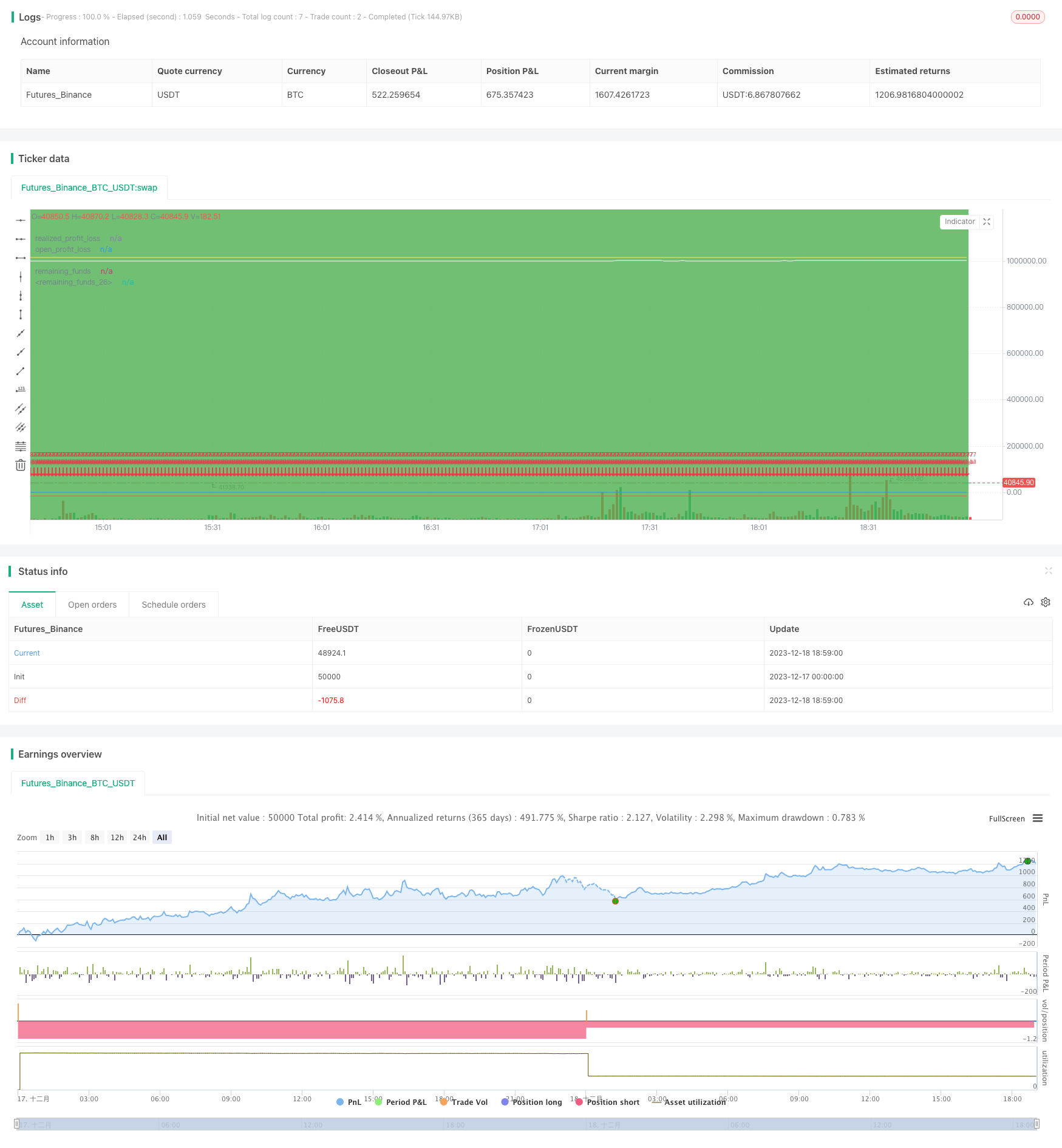
策略概述
本策略以50%资金和50%仓位进行动态平衡,通过不断调整仓位和资金比例,实现风险控制。适合无法实时监控市场的投资者。
策略原理
初始化本金100万元,分为50%资金和50%仓位。
在交易周期内,每天开盘时,如果剩余资金大于未实现盈亏的1.05倍,则用剩余资金的2.5%进行加仓。
如果未实现盈亏大于剩余资金的1.05倍,则卖出部分仓位,使之重新恢复到平衡状态。
在交易结束时,平仓清算所有头寸。
策略优势
通过资金和仓位的动态平衡,可以有效控制风险,最大程度避免极端行情的巨额损失。
不需要频繁监控市场,仅需要调整资金和仓位比例,操作简单,适合工作繁忙的投资者。
可以通过调整参数,实现不同程度的风险偏好,满足不同投资者的需求。
策略风险
无法捕捉市场短期涨跌,盈利空间受限。
如果行情出现长期单边突破,可能导致仓位比例过低,无法充分捕捉行情。
参数设置不当可能导致仓位调整过于频繁或资金利用率不高。
策略优化
可以引入更多参数,实现仓位和资金比例的更精细化控制。
可以结合止损止盈原理,在仓位较大时适当止损。
可以测试不同的交易周期参数设置,提升策略的适应性。
总结
本策略通过资金和仓位动态平衡的思路,实现了风险控制的目标。相比其他策略,操作简单,容易实现。后续通过引入更多可调参数以及结合其他策略思路,可以使策略更加完善。
策略源码
/*backtest
start: 2023-12-17 00:00:00
end: 2023-12-18 19:00:00
period: 1m
basePeriod: 1m
exchanges: [{"eid":"Futures_Binance","currency":"BTC_USDT"}]
*/
//@version=4
strategy("00631L Trading Simulation", shorttitle="Sim", overlay=true, initial_capital = 1000000)
// 设置本金
capital = 1000000
// 设置购买和出售日期范围
start_date = timestamp(2020, 11, 4)
next_date = timestamp(2020, 11, 5)
sell_date = timestamp(2023, 10, 24)
end_date = timestamp(2023, 10, 25) // 结束日期改为2023年10月25日
// 判断是否在交易期间
in_trade_period = true
// 实现的盈亏
realized_profit_loss = strategy.netprofit
plot(realized_profit_loss, title="realized_profit_loss", color=color.blue)
// 未实现的盈亏
open_profit_loss = strategy.position_size * open
plot(open_profit_loss, title="open_profit_loss", color=color.red)
// 剩余资金
remaining_funds = capital + realized_profit_loss - (strategy.position_size * strategy.position_avg_price)
plot(remaining_funds, title="remaining_funds", color=color.yellow)
// 總權益
total_price = remaining_funds + open_profit_loss
plot(total_price, title="remaining_funds", color=color.white)
// 购买逻辑:在交易期间的每个交易日买入 daily_investment 金额的产品
first_buy = time >= start_date and time <= next_date
buy_condition = in_trade_period and dayofmonth != dayofmonth[1]
// 出售邏輯 : 在交易期间的截止日出售所有商品。
sell_all = time >= sell_date
// 在交易期間的第一日買入50%本金
if first_buy
strategy.order("First", strategy.long, qty = capital/2/open)
// 在每个K线的开盘时进行买入
// 加碼邏輯 : 剩余资金 > 未实现的盈亏 * 1.05
add_logic = remaining_funds > open_profit_loss * 1.05
if buy_condition
strategy.order("Buy", strategy.long, when = add_logic, qty = remaining_funds * 0.025 / open)
//
// 減碼邏輯 : 剩余资金 > 未实现的盈亏 * 1.05
sub_logic = open_profit_loss > remaining_funds * 1.05
if buy_condition
strategy.order("Sell", strategy.short, when = sub_logic, qty = open_profit_loss * 0.025/open)
//
strategy.order("Sell_all", strategy.short, when = sell_all, qty = strategy.position_size)
// 绘制交易期间的矩形区域
bgcolor(in_trade_period ? color.green : na, transp=90)